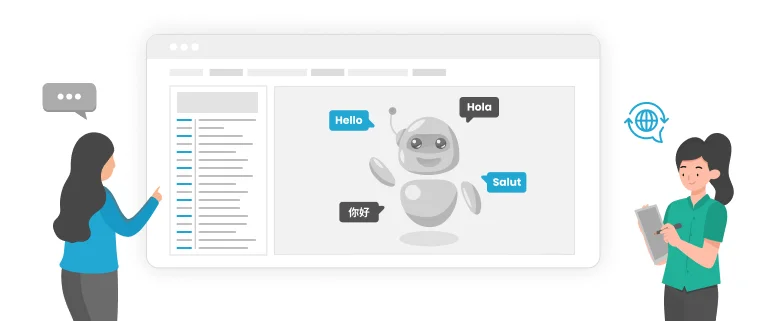The software development industry has experienced massive growth over the last decade. Given the fast-paced and rigorous competition among global firms, delivering top-tier quality is essential to survival. Software that is designed not only to function, but provide reliability, robustness, usability, and security is considered a quality product. But that is much easier said than done. QA in software is a time-consuming and challenging task. Moreover, if your software is multilingual, it is even more difficult to ensure consistent quality across different translated versions. For that, it would be better to have a reliable software translation service provider by your side.
Our blog today is focused on steps you can take to improve the quality of your software and ensure a successful product launch.
Table of Content
What is Software Quality?
The quality of the software is rated on the basis of meeting user requirements, as well as the industry’s best practices and standards. Moreover, software is rated on it meeting specified requirements, and how it functions without errors or lag.
Another basis for judging the quality of software is the availability of various aspects such as security, portability, usability, functionality, UI/UX, reliability, speed, and more.
Software developers, testers, and QA teams are there to view analysis, coding, design, testing, and maintenance. A good team ensures a higher quality of software and design.
Are You Familiar With The 3 C’s of Software Quality?
The three C’s that are vital to quality assurance are correctness, completeness, and competency.
Correctness
This is the measure of how well the software performs the functions it was intended for without any errors or bugs. Correctness of software is the first aspect of ensuring the quality of software. It is the process that ensures software value for its users.
Completeness
This is the process where a software application is judged on the basis of it performing its intended functions and fulfilling its requirements. Completeness is vital because it makes certain that the software performs all the tasks it was made to do and meets user requirements.
Consistency
This is the process in which the predictability and uniformity of software are measured across various environments and platforms. Consistency is vital to ensuring that a software can be used by a variety of users and how reliable it may be.
Strategies to Improve Software Quality
Four strategies that can improve software quality drastically:
1. Define Clear Requirements & Prioritize
Quality software is created through a solid understanding of what you are trying to create. The concept needs to be clear and ironclad. This means clearly defining requirements that capture the features, functionalities, and needs of the software.
- Gathering Input of Stakeholders
It is best to involve all stakeholders such as end users, developers, sales team, and product managers in the requirement gathering phase. This collaboration based approach will ensure a comprehensive understanding of your potential challenges at various stages and an understanding of your desired functionalities.
- Feature Prioritizing
Some features hold more importance than others and the use of prioritization techniques like the Moscow method (Must-Have, Should-Have, Could-Have, and Wont-Have) will help you categorize features based on their importance. This will allow you to manage time better and make the useful features more functional.
- Documentation
Experienced developers have this practice of creating coding documents. This allows them to find faults more easily after Q/A identifies the issues. The same can be done for the entire process and the documentation can serve as a focal point for all team members. Moreover, it will reduce the risk of misinterpretations and misunderstandings.
Example
Imagine you are making a new e-commerce platform. During the stakeholder meetings, you identify features like shopping cart functionality, payment methods, product search, and secure payment method integration. Such features are immensely important and are characterized as ‘Must-Have’. While additional features like a wishlist or product recommendation are categorized as ‘Should-Have’ based on user value.
2. Test Early and Frequently
The more technology grows, the more difficult it becomes to create a bug-free application. Hence, rigorous testing is necessary during various stages of the development process. By testing your application regularly, you can find and fix bugs sooner. Software localization services providers usually map out stages of testing and methods. This often makes availing services cheaper than employing in-house teams.
- Shift Left Testing
The concept of ‘shift left testing’ refers to the importance of testing software during the early stages of the development cycle. This can involve exploratory testing for the initial prototypes or unit testing when developing the software.
- Leverage Automation
These are automated tools for testing that are streamlined to ensure consistent testing of software. Tools such as Cypress or Selenium are used to automate web application testing. Moreover, tools such as Mockito or JUnit are used for testing Java based software.
- Use a Combination of Testing
It is best to use various methods of testing, rather than relying on a single method. You can use a combination of various testing methods such as integration testing, unit testing, user acceptance testing (UAT), and system testing. The multiple testing approach will allow you to find a wider range of potential issues.
Example
Let’s continue the example of the e-commerce platform. You can test things such as shopping cart logic or search algorithms by doing unit tests. Integration testing will allow you to ensure seamless functioning of various parts of the software, for instance, shopping carts interaction with the payment methods. Lastly, UAT with users will help you collect feedback data on the overall usability experience.
3. Implement Continuous Delivery and Integration
CD/CI pipelines streamline the delivery and development process, ensuring more reliable and faster release of software.
- Continuous Integration
With continuous integration, changes of code from developers are more regular and are merged in the central repository more frequently. This provides immediate feedback on the code quality as automated tests and builds are triggered.
- Continuous Delivery
The deployment process can be automated, thanks to extending the CI/CD pipelines. This helps you do more deployments of smaller code changes and reduces the risk of new bugs that may arise from new code implementation.
- Better Quality & Faster Release
Such practices not only improve the quality of the software but also help in detecting bugs sooner, speeding up delivery cycles. This regular update of features helps get software into the hands of users sooner.
Example:
Reimagine your e-commerce platform, you can automatically test codes right after a developer makes a change to the software. In case a test is failed, the developer is informed instantly, this allows them to fix the issue before the code is merged with the main database. This allows you to save a lot of time and money later on. Moreover, the pipeline can be composed to deploy the code automatically, before being pushed into production.
Create a Quality Culture
If you want to build a quality product / software then you also need a team that has the right mindset and skills. Their mindset will prioritize quality above everything.
Team Training
This allows your team to learn new methods and skills. Both developers and testers will improve in quality. Moreover, your team will understand the latest and best practices to ensure quality code and software.
Regular Team Meetings
This creates an open platform for your employees to share their thoughts and ideas. Moreover, it fosters a culture that thrives on mutual success. You are more likely to know your team’s morale and concerns.
Open Culture
Allow your team members to express themselves. Even if someone says something ridiculous, the environment should be nurturing. This allows you to identify your best assets.
Final Thoughts
The quality of your software relies on certain aspects. However, the most important ones are your employees and your streamlining process. You can also avail quality assurance from localization firms. This can be especially useful if you are looking to penetrate different markets as the software can be adapted for each market release, something Microsoft often does so well.
If you are planning to go global with your software and need a professional translation company by your side to ensure high-quality translations, CCJK is just a click away.
Get in touch for more details!



